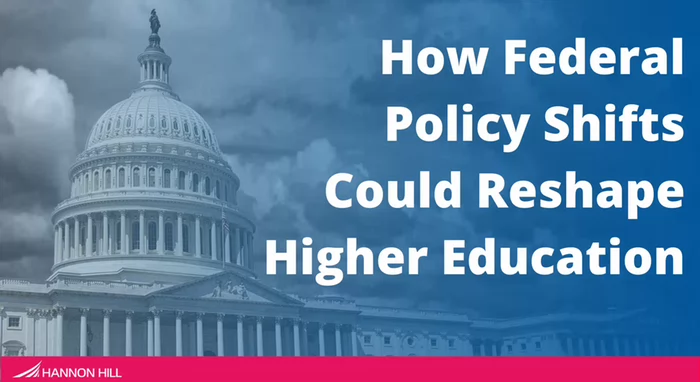
As 2025 unfolds, federal policy shifts could significantly impact higher education institutions nationwide.
Most notably, the reported intention to eliminate the Department of Education, which plays a major role in funding, accessibility and disability services, and DEI initiatives might cause colleges and universities, and especially current and prospective students, some trepidation.
If enacted, this change could reshape how federal financial aid is distributed, alter compliance requirements, and shift oversight responsibilities to states.
While these changes may require adjustments, institutions can take proactive steps to ensure that financial aid, accessibility, and student privacy remain priorities.
We understand that in times of uncertainty, it can be difficult to see a clear path forward.
While your institution is wrestling with these unanswered questions, here are some actionable steps you can take today to ensure the confidence of your students, faculty, and staff while fostering a welcoming and supportive environment.
The most important thing you can do is stay informed about the changes that may be coming for your institution.
Designate a specific member of staff to stay on top of news updates and watch for announcements, mandates, or changes that might affect higher education.
With so many media outlets available, it’s important to identify the ones that provide the most relevant and insightful news for your institution.
We recommend keeping an eye on trusted sources that focus on accuracy and education-related coverage.
Once you have narrowed down the most relevant, accurate sources of information, it will be easier to check for news updates periodically throughout the day.
You may also set up Google Alerts or subscribe to newsletters from these sources to receive timely updates on federal education policy changes.
Action plan:Your institution is vital in guiding students, faculty, and families through change.
Proactively communicating your commitment to accessibility, financial aid, and student success will help build confidence and clarity.
Consider crafting a response statement to make your position clear.
First, reaffirm your commitment to accessibility.
This will ensure students that their place in your school is not at risk due to changes in accessibility or DEI initiatives.
It will be important to share critical changes and updates with students, staff, and faculty. Set up an information hub or resource center to inform your community about the changes, and include an up-to-date news ticker.
In addition to news, the resource hub should include links to advocacy groups, a robust alumni support section, and mental health resources. Make sure your students know you are there to support them with a variety of resources.
Everyone will have questions, so it’s important to provide a list of FAQs about compliance, financial aid, funding, and other logistics.
If the Department of Education is dismantled, Pell Grants and federal student loans could be transferred to the Department of the Treasury or a new agency.
Institutions should stay informed about how these changes might affect financial aid distribution.
Many students may be anxious about how the restructuring or elimination of the Department of Education and other policies and initiatives may affect their grants and loans.
However, there are other scholarships and grants available from individuals and non-government sources, and you can help your students find and apply for appropriate funding.
Action plan:If federal education policies shift, international students may face additional challenges in securing visas, funding, and work authorization.
It’s essential to track changes in visa policies under the Department of Homeland Security (DHS) and U.S. Citizenship and Immigration Services (USCIS).
We recommend monitoring USCIS’s Student Visa Portal for updates.
Visa guidance is an essential resource for your international students.
Consider rolling out a centralized hub for visas, travel, and work authorization, as well as FAQ sections on F-1, J-1, OPT, CPT, and travel restrictions. You may also provide links to Official Sources, such as USCIS, DHS, SEVP, and embassy websites.
In addition, be sure to provide resources such as regularly updated travel guidelines, emergency contact info, such as a 24/7 support line for students traveling abroad, and checklists for re-entry to help students prepare for returning to the U.S. after trips home.
Employ a dedicated visa specialist in your admissions department to help students navigate the complicated requirements of obtaining a visa and make their contact information readily available on your website.
By providing dedicated visa guidance and translation services, institutions can help international students navigate the application process with more confidence.
Continue to prioritize international students, even after they are enrolled. Make sure that they feel valued, and supported, and that they have the resources they need.
Action plan:Higher education has always been a pillar of progress, and institutions have continuously adapted to change. By leveraging strategic communication tools and digital resources, your institution can proactively support students and faculty while navigating federal policy shifts.
By providing resources personalized to each demographic of potential or current student, you will be able to speak directly to their concerns. Hannon Hill’s suite of tools offers the resources you need to easily create and publish content that will help students navigate this uncertain time.
Hannon Hill is here to provide resources for higher education institutions to protect, inform, and continue to educate their students.Last Updated: Mar 20, 2025 11:00 AM